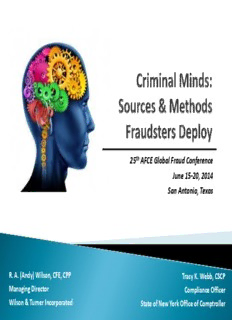
25th AFCE Global Fraud Conference June 15-20, 2014 San Antonio, Texas PDF
Preview 25th AFCE Global Fraud Conference June 15-20, 2014 San Antonio, Texas
25th AFCE Global Fraud Conference June 15-20, 2014 San Antonio, Texas R. A. (Andy) Wilson, CFE, CPP Tracy K. Webb, CSCP Managing Director Compliance Officer Wilson & Turner Incorporated State of New York Office of Comptroller Wilson & Turner Incorporated State of New York Comptroller ◦ Compliance Officer ◦ Managing Director ◦ Pension Investments & Cash ◦ Fraud Practitioner for 28 years Management Faculty Appointments: Boards: ◦ The University of Memphis ◦ Economic Crime and Cybersecurity ◦ Utica College of Syracuse University Institute ◦ National Society of Compliance Previous: Professionals ◦ Attorney General Previous: ◦ Southland Corporation ◦ INTECH ◦ Germantown Police ◦ GenSpring Family Offices Department Certifications: ◦ CSCP, Certified Securities Compliance Professional R. A. (Andy) Wilson, CFE, CPP Tracy K. Webb, CSCP An Introduction to Fraud Fraud Theories The Main Sources Fraudsters Use A Fraudster’s Method of Approach Fraud Symptoms Used to ID Ethical Decisions People Make Preventing Good People from Doing Bad Things Identifying Fraud through Detection Questions & Answers 25th AFCE Global Fraud Conference June 15-20, 2014 San Antonio, Texas - An Introduction to Fraud - R. A. (Andy) Wilson, CFE, CPP Tracy K. Webb, CSCP Managing Director Compliance Officer Wilson & Turner Incorporated State of New York Office of Comptroller Is a generic term, and embraces all the multifarious means which human ingenuity can devise, which are resorted to by an individual, to get an advantage over another by false representations. No definite and invariable rule can be laid down as a general proposition in defining fraud as it includes surprise, trickery, cunning and unfair ways by which another is cheated. The only boundaries defining it are those which limit human imagination. Webster’s New World Dictionary College Edition A representation About a material point, Which is false, And intentionally or reckless, Which is believed And acted upon by the victim To the victim’s damage Fraud is different from unintentional errors. There must be intent! Asset Misappropriation Classifications of Fraud Opportunity Concealment Fraud Triangle Fraud Elements Typical organizations loose ◦ 5% of revenues to fraud (globally, $3.7 trillion) Median fraud loss $145,000 Median duration 18 months Fraud types ◦ Asset misappropriations 85%, median loss $130,000 ◦ Financial statement 9%, median loss $1,000,000 ◦ Corruption 37%, median loss $200,000 One third of the cases involved two or more types Tips are the main detection method at 40% (2x others) ◦ Employees ID fraud more than half the time Hotlines work! ◦ Identify frauds quicker (50% faster) ◦ Less costly (by 41%) Industry ◦ Banking and financial services, manufacturing, government Higher the authority level, the greater the losses 77% of fraud committed by persons in these departments ◦ Accounting ◦ Operations ◦ Sales ◦ Executive Sources of Attack ◦ Customer service ◦ Purchasing ◦ Finance
Description: